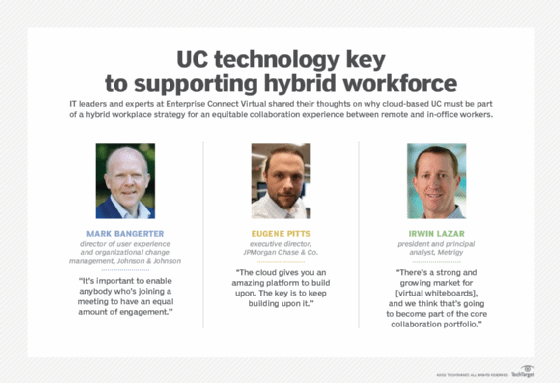
Kateryna - stock.adobe.com
Hybrid workplace model starts with meeting rooms, video
The hybrid workplace is the future as not everyone will return to the office full time. Learn how IT leaders at Enterprise Connect Virtual are using UC to support a hybrid workplace model.
When the pandemic struck, Johnson & Johnson pivoted to a work-from-home strategy and rolled out the necessary collaboration tools to support remote communications and workflows. In 12 months, the company moved from Skype for Business Online to Microsoft Teams and Zoom.
As the healthcare company and its employees have settled into the new normal, the priority now is to find the best way to support the future of the workplace as some employees start their return to the office, while others stay remote.
The challenge is understanding what the new work model will look like, said Mark Bangerter, director of user experience and organizational change management at Johnson & Johnson, based in New Brunswick, N.J. Bangerter, other business leaders and IT experts spoke at Enterprise Connect Virtual on the strategies for a post-pandemic workplace.
No one knows what the right percentage of remote, hybrid and office-based workers should be, and that balance will change over the next two to three years, he said. But organizations need to determine the right setup to support those three states of working.
Meeting rooms kick-start the hybrid workplace
For Bangerter, the right setup for a hybrid workplace model means focusing on meeting spaces. Before the pandemic, remote participants dialed into a meeting and would get a second-class experience compared to employees who were physically present. The challenge is making remote participants feel like they're part of the meeting space.
"It's important to enable anybody who's joining a meeting to have an equal amount of engagement," he said. At Johnson & Johnson, Bangerter is evaluating newer technology to deploy in thousands of meeting spaces in offices across 60 countries. He's also taking advantage of most offices being closed due to the pandemic to gradually upgrade meeting spaces for more effective setups to support remote meetings.
Video will generally replace in-person meetings as most teams will be distributed in a hybrid workplace model, Metrigy analyst Irwin Lazar said. Organizations will need to optimize meeting spaces with the right equipment or even turn larger conference rooms into smaller meeting spaces.
"Meeting rooms must evolve," Lazar said. "The idea of 15 people walking into a conference room, putting a pot of coffee in the middle of the table and spending all day in that room is probably not going to happen again anytime soon."
Companies are adding video equipment to meeting rooms in the expectation that, when employees return to the office, they will need video everywhere. Some employees may even go into the office but prefer to participate in a meeting from their desk using video, he said.

The value of cloud-based video
JPMorgan Chase & Co. already had a culture of video with an on-premises system that supported conference rooms, executive desktop units and video phones for nearly 250,000 employees. Prior to the COVID-19 pandemic, employees held about 1 billion minutes' worth of meetings, said Eugene Pitts, executive director at JPMorgan, based in New York.
But an on-premises video system had its limitations. The financial services company could average 30,000 concurrent calls per day, but only had the resiliency to support 7,000 concurrent calls on external networks, such as home networks, Pitts said.
He began evaluating cloud video conferencing services for better resiliency and the ability to offload capacity to a service provider. Now, the idea of limiting calls for users on external networks is irrelevant, he said. Since the pandemic, video usage is around 25 million minutes per day with upward of 60,000 concurrent meetings.
"Was I planning for a COVID-like situation with everybody working from home? No, but it was certainly a positive outcome," he said.
Another benefit of the cloud is new features can be deployed faster than with on-premises systems, especially AI capabilities. JPMorgan's on-premises system lacked the speed and computing power to add new capabilities.
"The cloud gives you an amazing platform to build upon," Pitts said. "The key is to keep building upon it."
New trends support hybrid workplace efficiency
New ways of working are also driving new trends in the unified communications (UC) space. At JPMorgan, Pitts said he wants to explore a new use case of asynchronous video communications and open up video creation and distribution to employees.
Asynchronous video communication could potentially displace email through short-form video messages -- similar to consumer apps, like Snapchat and TikTok -- where a user could record a quick video instead of sending an email, he said.
AI is another UC trend that could boost productivity for a hybrid workforce with capabilities like meeting transcription, live captioning and action items. AI could also process audio and data points to feed information to sales teams to enable quicker and more effective client calls. AI could make meetings more effective by analyzing audio to determine decision-making and what issues require follow-up, Bangerter said.
Virtual whiteboards are another growing trend that Bangerter is following closely in his strategy to support a hybrid workplace model.
"Advanced virtual collaboration technology is going to become more important as we try to take that meeting room outside the meeting space and make it as engaging for people joining virtually as it is for people joining in person," he said.
More than 40% of companies are adopting or planning to adopt virtual whiteboard apps, Lazar said.
"There's a strong and growing market for them, and we think that's going to become part of the core collaboration portfolio," he said.
AI could also be applied to virtual whiteboards through applications like sentiment analysis, Bangerter said. Applying sentiment analysis to virtual whiteboards could help with decision-making by identifying where meeting participants agree or don't agree on certain topics. Sentiment analysis could also make decisions for participants based on whiteboard data, he said.








